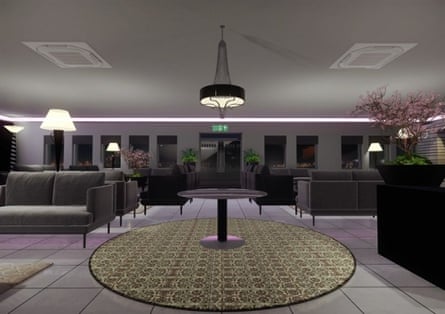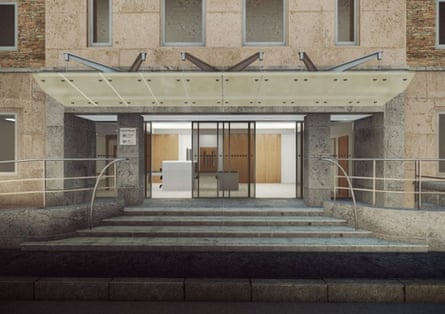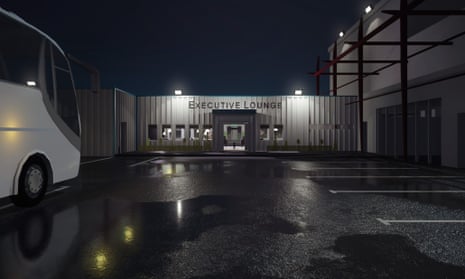It’s a cold, wet night in December 2013. I’m sat in a car park on the far side of Stansted airport, and most of the day’s flights have already departed. This side of the runway is home to half a dozen private hangars. Harrods Aviation is here, providing engineering services and “fast, effortless and discreet arrivals and departures”. When I flew through Stansted in the summer as a tourist, one of the 747s in the Dubai royal family’s private fleet was parked on its apron. Also here is the Inflite Jet Centre, which presents itself online as something between a boutique hotel and a serviced office complex, offering “luxurious” furnishings, on-site chef and meeting rooms.
Not everyone who visits Inflite gets to enjoy such facilities, however. I’m here to witness some of the terminal’s other visitors: those who come only at night, and only when the regular customers have jetted off. At around 9pm, a series of coaches start to arrive, accompanied by police and private security vans. Most of them are from WH Tours in Crawley; one bears the exuberant legend of the holiday company “Just Go!” The coaches have come from detention centres all over England. They are carrying people who are being deported.

The Inflite Jet Centre is one of three architectural spaces I explore in Seamless Transitions, a short film commissioned by the Photographers’ Gallery in London as part of a season looking at human rights and social justice. The other two are a detention centre and a courtroom. Each is a key part of the UK immigration system, but each is also “unphotographable” for reasons of security, secrecy or law. In order to recreate them, I had to acquire planning documents and satellite photos, interview academics and activists, and read the reports and accounts of those subject to their machinations. Working with Picture Plane, an architectural visualisation firm, we recreated the three spaces as 3D computer models. Most of us are lucky enough never to be forced to inhabit these spaces, but that does not mean we should acquiesce to them remaining unseen.
I was at Stansted because I’d been following the case of Isa Muazu, a Nigerian man the government had tried to deport a week earlier. Reading the newspapers, I was intrigued that, like Abu Qatada before him, Muazu had been flown out of the country on a luxury private jet – in this case, a 13-seater Embraer Legacy 650 operated by Air Charter Scotland. ACS have two Legacys in their fleet; the other belongs to Alan Sugar. I found the owner and model of the plane because I studied planespotter logs and the FlightRadar24 planetracking website; unsurprisingly, companies involved in this process don’t tend to make a lot of noise about it, and the Home Office refuses to release details of the programme. The main reason the government uses private planes is because commercial carriers (and their passengers) don’t like flying people under duress, especially after the horrific death by suffocation of deportee Jimmy Mubenga aboard a BA flight in 2010.

Muazu’s case had attracted particular attention because, prior to his deportation, he’d been on hunger strike for three months at Harmondsworth, one of the Home Office’s detention centres. Such facilities hold up to 3,000 people at any time, either expecting decisions on their immigration status, or awaiting deportation. Under the Detained Fast Track system, many people who claim asylum are detained on arrival in the country and imprisoned in one of these facilities, with poor access to legal advice and healthcare. In our computer rendering of Harmondsworth, the centre looks authentically prison-like, but much too clean: detainees and official inspector reports complain of dirt and overcrowding. A recurring note in visitor accounts is the smell – not just of bodies, but of stress, confusion and fear.
Politicians on all sides – when it suits them – have criticised the current asylum system. Human-rights groups and courts have questioned the legality of many of its aspects. Successive reports over a decade have decried the conditions, management and humanity of the flights and detention centres. Newspaper stories every month recount a litany of abuses, deaths, broken families and traumatised individuals. But even if you don’t know these stories, just watching people of colour being loaded off buses by burly men in hi-vis jackets at night is enough to tell you something inhumane, morally embarrassing, legally questionable and fundamentally objectionable is going on.
This invisibility and secrecy is what sustains the system, even as it corrupts it. The third location in our film is Field House in the City of London. This is home to SIAC, the Special Immigration Appeals Commission, which hears asylum and citizenship cases involving the security services. When I went to visit SIAC, one of the guards told me how proud he was to work there, because: “It’s transparent. It’s open to the public and anyone can come and see justice being done.” But after I’d handed over my camera and recording equipment, and gone down the stairs to court number one, I found the door was locked. The court was in secret session: under the special rules of SIAC, not even the defendant nor their legal team are allowed into the room to know the evidence against them.

The irony was that this particular case was convened because the closed-session process had just been deemed illegal by the European Court of Justice, and the court was trying to work out how to proceed. After a couple of hours, we were let in only to be told that the case was adjourned, and no reason could be given. So much for open justice. So much for a fair trial.
Computer renderings are far from reality. We know this from the glossy, fake CGI interiors of the Ikea catalogue and the permanently sunny piazzas on the hoardings of city-centre developments. But, just as these image-making technologies structure our perception of the world, they can also allow us to see inside places and processes that would otherwise remain invisible.

Comments (…)
Sign in or create your Guardian account to join the discussion